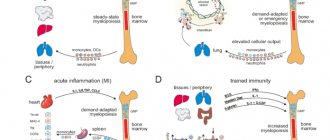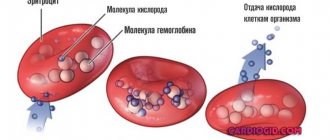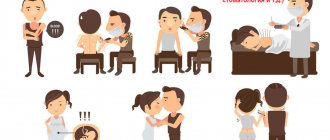In the article we will look at what it means when a child’s monocytes are low.
Monocytes in the baby’s body are divided into two main categories: marginal and circulating. The former are constantly present in the blood (twenty-five percent of all formed in the bone marrow). It is their value that is determined during general clinical blood tests. The marginal ones (seventy-five percent) are primarily those that remain in the brain. They enter the bloodstream when there is an increased need for these cells, for example, during acute inflammation. This helps to cope with pathological processes in the shortest possible time. As a rule, the balance of monocytes is affected by helminth infestations along with infection by protozoa in the form of leishmania, amoebae, toxoplasma, etc. This is a very important criterion that determines the further examination program for children.
Very often, tests reveal that a child’s monocytes are low. What does this mean?
The role of monocytes in the children's body
Monocytes are one of the white blood cells. Unlike the same neutrophils, eosinophils and basophils, they do not contain granules, which is why they are called agranulocytes. The counting of cells in a blood test is based on this fact. Monocytes serve as short-lived cells (this period usually ranges from one and a half to three days). Granulocytes, by comparison, usually live from one hundred to three hundred days.
What does it mean when lymphocytes are low and monocytes are high in a child? Let's figure it out.
Monocytes are formed in the bone marrow and then enter peripheral tissue. In it, these cells differentiate, as a rule, into macrophages. To perform their physiological function, they require the presence of oxygen, since it is necessary for the production of energy. Under anaerobic conditions they can also function normally, but less efficiently. Usually this happens in foci of purulent inflammation.
Receptors that are located on the surface of monocyte macrophage cells recognize damaged cells along with microbes, pathological mediators, and so on. This serves as a trigger stimulus that activates the monocyte macrophage unit. This may be accompanied by the formation of hydrogen peroxide, superoxide ions, hydroxide radicals, and the like. All these components provide the body's immunity.
Is it dangerous when a child’s monocytes are low?
What level is considered low?
Monocytes can be easily distinguished in a laboratory study by their large size and large oval nucleus without constrictions.
The norm of monocytes in a blood test is taken into account by absolute value and relative indicator. Leukocyte cells are counted from a stained blood smear in a certain volume. It is most convenient to use the calculation per liter.
The lower limit of normal for monocytes is set for children - 0.05 x 109/l, for adults the figure is 0.08 x 109/l - the upper limit, zero cell value is considered low. You can read more about the normal range of monocytes in children here.
Based on the relative content of monocytes among the entire group of leukocytes, the rate below normal is estimated in children, depending on age, at less than 3–5%; in adults, a decrease from 3% to zero.
Most often, when the immune system is suppressed, a reduced level of leukocytes in general, as well as lymphocytes along with monocytes, is determined.
Any microorganisms that come into contact with the skin become dangerous.
- Lymphocytes and monocytes are elevated in adults
Consequences of relegation
Monocytes in a child’s body perform a variety of functions and their reduction is fraught with certain cavities:
- Weak fight against pathogenic bacteria.
- Insufficient regulation of the immune response and inflammatory reactions.
- Insufficient control over the restoration of damaged tissue.
- Weak antitumor effect.
- Dysregulation of bone marrow functions to produce all blood cells.
- Poor digestion of defective cells.
Threat with monocytopenia
Monocytopenia is a symptom that should not be ignored
Decreased monocyte counts may be a natural occurrence and not something to worry about, only in pregnant women. However, not always: even pregnant women need to constantly make sure that there are no deviations under the supervision of a doctor.
Maintaining monocyte counts within normal limits is essential. They are protectors that destroy foreign pathological agents, and also fight various infections, fungal diseases and help fight malignant cancer tumors.
In addition to the individual duties of monocytes, they, like other blood cells, perform the following functions:
- Increased level of monocytes in the blood of an adult: what does this mean, reasons
- Destruction and prevention of the development of potentially dangerous pathogenic bacteria.
- Regulation of the body's immune responses to inflammatory processes.
- Control over protein production.
- Destruction of obsolete, damaged and defective cells from the body.
- Creating a favorable environment for tissue regeneration after external and internal damage.
The role played by monocytes is very important in the overall functioning of the body, so it responds negatively to any decrease in their number.
Monocyte norms
How is it determined that a child’s monocytes are low? What are the norms?
The number of monocytes in the blood is constant throughout life. Therefore, the norms of such cells in adults and small patients are practically the same. The normative upper limit of their number is eleven percent in relation to other leukocytes. A decrease in monocytes of less than three percent is called monocytopenia, and an increase of more than eleven is called monocytosis.
It happens that lymphocytes are low and monocytes are high in a child. More on this below.
However, it is necessary to distinguish between absolute and relative monocytopenia. In the absolute form, we are talking about the overall value of cells of a given type, that is, this parameter is expressed in the number of monocytes per liter. Its normative limit is 0.09 ∙ 10⁹/l. A decrease in monocytes below this value is absolute monocytopenia, and an increase of more than 0.6 ∙ 10⁹/l is monocytosis.
Thus, the concept of absolute and relative monocytopenia coincides only when the percentage and total number of monocytic and macrophage cells decreases. They cannot coincide when there is a multidirectional decrease in monocytes. Typically, such an imbalance in the leukoformula may indicate an extremely serious condition in the child, requiring a longer examination and prompt initiation of therapy. Next, we’ll talk about the main factors that influence the decrease in the blood indicator in question in the child’s body.
Why are there low monocytes in a child?
Monocytes and macrophages: what is the difference?
In the 70s of the last century, it was believed that all monocytes sooner or later turn into macrophages, and there are no other sources of “professional janitors” in the tissues of the human body. In 2008 and later, new studies were conducted that showed that macrophages are heterogeneous. Some of them actually originate from monocytes, while others arise from other progenitor cells even at the stage of intrauterine development.
The transformation of some cells into others follows a programmed pattern. Coming out of the bloodstream into the tissue, monocytes begin to grow, and the content of internal structures - mitochondria and lysosomes - increases. Such rearrangements allow monocyte macrophages to perform their functions as efficiently as possible.
Main causative declines in children
Cases when a child's monocytes are below normal are called monocytopenia in medicine. This is usually observed in the following conditions:
- Against the background of sepsis, there are low monocytes in the blood of a child, which is a serious process caused by the presence of pathogenic microbes in the body that circulate in the blood and enter various organs.
- The development of leukemia is a pathological proliferation of cells in the brain that simply do not have time to undergo differentiation, and therefore they do not perform their proper functions. They cause harm to the body (we are talking about tumors of the hematopoietic system). Immature blood cells can affect various organs.
Now let's look at the symptoms of the described deviation.
Carrying out analysis
It is possible to determine whether a child has low monocytes or not only by conducting a laboratory full-type blood test. Blood is drawn from a finger.
To ensure that the results correspond to reality, you must adhere to some rules:
- What are monocytes and what is the normal level of their content in the blood of men, women and children?
- you need to take tests on an empty stomach;
- one day before donating blood, you should stop taking medications, if possible;
- physical and emotional stress should be excluded;
- At the time of taking the tests, it is necessary that the person is in a calm emotional state.
If it is discovered that the monocytes in the blood of a child or adult are too low, the doctor may prescribe an additional examination and repeat the test to rule out an error.
Symptoms
How does a condition manifest when monocytes in a child’s blood are low?
As a rule, these elements decrease against the background of an increase in other leukocytes. In this regard, monocytopenia occurs in acute lymphoblastic or myeloblastic leukemia. However, this symptom is not a specific sign, and only on its basis the diagnosis is never made. This is an accompanying manifestation that may or may not exist. Symptoms may also be as follows:
- The appearance of anemia associated with suppression of bone marrow functions.
- The development of anemia arising from a deficiency of B12 or folic acid.
- The appearance of systemic lupus, which is an autoimmune disease in which skin lesions are observed, the kidneys, and sometimes other organs are affected.
It is important to note that conditions in which monocytes are reduced in a child are extremely serious. They indicate severe leukemic changes. Therefore, the level of these elements in the blood is a very important criterion, which indicates the adequacy of therapy. A zero monocyte count can even be life-threatening and is incompatible with it. Such cells are an important indicator of the child’s immunity.
Reasons for the increase in monocytes in the blood
An increase in monocytes above the threshold value for each age group is called monocytosis. There are two forms of this condition:
- Absolute monocytosis is a phenomenon when there is an isolated growth of monocytes in the blood, and their concentration exceeds 0.8*109/l for adults and 1.1*109/l for children under 12 years of age. A similar condition is recorded in some diseases that provoke the specific production of professional phagocytes.
- Relative monocytosis is a phenomenon in which the absolute number of monocytes remains within normal limits, but their percentage in the bloodstream increases. This condition occurs when the level of other white blood cells decreases simultaneously.
In practice, absolute monocytosis is a more alarming sign, since it usually indicates serious problems in the body of an adult or child. The relative increase in monocytes is often transient.
What does an excess of monocytes indicate? First of all, it means that phagocytosis reactions have started in the body, and there is an active fight against foreign invaders. The following conditions can cause monocytosis:
Physiological causes of monocytosis
In all healthy people, monocytes increase slightly in the first two hours after eating. It is for this reason that doctors recommend donating blood exclusively in the morning and on an empty stomach. Until recently, this was not a strict rule, and a general blood test with determination of the leukocyte formula was allowed to be done at any time of the day. Indeed, the increase in monocytes after a meal is not so significant and usually does not exceed the upper threshold, but the risk of incorrect interpretation of the result still remains. With the introduction into practice of devices for automatic decoding of blood, sensitive to the slightest changes in cellular composition, the rules for taking the test were revised. Today, doctors of all specialties insist that the OAC be taken on an empty stomach in the morning.
High monocytes in women occur in some special situations:
Menstruation
In the first days of the cycle, healthy women experience a slight increase in the concentration of monocytes in the blood and macrophages in the tissues. This is explained quite simply - it is during this period that active rejection of the endometrium occurs, and “professional janitors” rush to the hearth to perform their immediate duties. The growth of monocytes is observed at the peak of menstruation, that is, on the days of the most heavy discharge. After the monthly bleeding is completed, the level of phagocyte cells returns to normal.
Important! Although the number of monocytes during menstruation usually does not go beyond the normal range, doctors do not recommend taking a complete blood count until the end of your monthly discharge.
Pregnancy
The restructuring of the immune system during pregnancy leads to low levels of monocytes in the first trimester, but then the picture changes. The maximum concentration of blood cells is recorded in the third trimester and before birth. The number of monocytes usually does not exceed the age norm.
Pathological causes of monocytosis
Conditions in which monocytes are so elevated that they are determined in a general blood test to be outside the normal range are considered pathological and require mandatory consultation with a doctor.
Acute infectious diseases
The growth of professional phagocytes is observed in various infectious diseases. In a general blood test, the relative number of monocytes in ARVI slightly exceeds the threshold values accepted for each age. But if during a bacterial infection there is an increase in neutrophils, then in the event of a viral attack, monocytes enter the battle. A high concentration of these blood elements is recorded from the first days of illness and persists until complete recovery.
- After all symptoms subside, monocytes remain high for another 2-4 weeks.
- If an elevated monocyte count is recorded for 6-8 weeks or more, a source of chronic infection should be sought.
With a common respiratory infection (cold), the level of monocytes increases slightly and is usually at the upper limit of normal or slightly beyond its limits (0.09-1.5 * 109/l). A sharp increase in monocytes (up to 30-50*109/l or more) is observed in oncohematological diseases.
An increase in monocytes in a child is most often associated with the following infectious processes:
Infectious mononucleosis
The disease caused by the herpes-like Epstein-Barr virus occurs primarily in preschool children. The prevalence of the infection is such that almost everyone gets it by adolescence. It almost never occurs in adults due to the peculiarities of the immune system's response.
Symptoms:
- Acute onset with fever up to 38-40 °C, chills.
- Signs of upper respiratory tract damage: runny nose, nasal congestion, sore throat.
- Almost painless enlargement of the occipital and submandibular lymph nodes.
- Skin rash.
- Enlarged liver and spleen.
Fever during infectious mononucleosis persists for a long time, up to a month (with periods of improvement), which distinguishes this pathology from other acute respiratory viral infections. In the general blood test, both monocytes and lymphocytes are elevated. The diagnosis is made based on the typical clinical picture, but a test for specific antibodies may be performed. Therapy is aimed at relieving the symptoms of the disease. Targeted antiviral treatment is not carried out.
Other childhood infections
The simultaneous growth of monocytes and lymphocytes is observed in many infectious diseases that occur mainly in childhood and are almost not detected in adults:
- measles;
- rubella;
- whooping cough;
- mumps, etc.
In these diseases, monocytosis is observed in the case of protracted pathology.
In adults, other causes of an increase in the number of monocytes in the blood are identified:
Tuberculosis
A severe infectious disease that affects the lungs, bones, genitourinary organs, and skin. You can suspect the presence of this pathology based on certain signs:
- Long-lasting causeless fever.
- Unmotivated weight loss.
- Prolonged cough (with pulmonary tuberculosis).
- Lethargy, apathy, increased fatigue.
Annual fluorography helps identify pulmonary tuberculosis in adults (in children, the Mantoux test). A chest x-ray helps confirm the diagnosis. To detect tuberculosis of other localizations, specific studies are carried out. In the blood, in addition to an increase in the level of monocytes, there is a decrease in leukocytes, erythrocytes and hemoglobin.
Other infections can lead to monocytosis in adults:
- brucellosis;
- syphilis;
- sarcoidosis;
- cytomegalovirus infection;
- typhoid fever, etc.
The growth of monocytes is observed during a prolonged course of the disease.
Parasitic infestation
Activation of monocytes in the peripheral blood is observed during helminth infection. These can be either opisthorchid, bovine or pork tapeworm, pinworms and roundworms, which are common in temperate climates, or exotic parasites. When the intestines are damaged, the following symptoms occur:
- Abdominal pain of various localizations.
- Loss of stool (usually diarrhea).
- Unmotivated weight loss due to increased appetite.
- Allergic skin reaction such as urticaria.
Along with monocytes, an increase in eosinophils, granulocytic leukocytes responsible for the allergic reaction, is recorded in the blood of a person infected with helminths. To identify parasites, feces are taken for analysis, bacteriological cultures are done, and immunological tests are performed. Treatment includes taking antiparasitic medications depending on the source of the problem found.
Chronic infectious and inflammatory processes
Almost any indolent infection that exists in the human body for a long time leads to an increase in the level of monocytes in the blood and the accumulation of macrophages in tissues. It is difficult to identify specific symptoms in this situation, since they will depend on the form of the pathology and the location of the lesion.
This could be an infection of the lungs or throat, heart muscle or bone tissue, kidneys and gallbladder, or pelvic organs. This pathology is manifested by constant or periodically occurring pain in the projection of the affected organ, increased fatigue, and lethargy. Fever is not typical. After identifying the cause, optimal therapy is selected, and as the pathological process subsides, the level of monocytes returns to normal.
Autoimmune diseases
This term refers to conditions in which the human immune system perceives its own tissues as foreign and begins to destroy them. At this moment, monocytes and macrophages come into play - professional phagocytes, well-trained soldiers and janitors, whose task is to get rid of the suspicious focus. But with autoimmune pathology, this focus becomes one’s own joints, kidneys, heart valves, skin and other organs, from which all the symptoms of the pathology appear.
The most common autoimmune processes:
- Diffuse toxic goiter is a lesion of the thyroid gland, in which increased production of thyroid hormones occurs.
- Rheumatoid arthritis is a pathology accompanied by the destruction of small joints.
- Systemic lupus erythematosus is a condition that affects skin cells, small joints, heart valves, and kidneys.
- Systemic scleroderma is a disease that affects the skin and spreads to internal organs.
- Type I diabetes mellitus is a condition in which glucose metabolism is impaired, and other parts of metabolism are also affected.
The growth of monocytes in the blood in this pathology is only one of the symptoms of systemic damage, but does not act as a leading clinical sign. To determine the cause of monocytosis, additional tests are required taking into account the suspected diagnosis.
Oncohematological pathology
A sudden increase in monocytes in the blood is always scary, as it may indicate the development of malignant blood tumors. These are serious conditions that require a serious approach to treatment and do not always end well. If monocytosis cannot be associated with infectious diseases or autoimmune pathology, you should see an oncohematologist.
Blood diseases leading to monocytosis:
- Acute monocytic and myelomonocytic leukemia. A variant of leukemia in which monocyte precursors are detected in the bone marrow and blood. It is found mainly in children under 2 years of age. Accompanied by signs of anemia, bleeding, and frequent infectious diseases. There is pain in the bones and joints. It has a poor prognosis.
- Multiple myeloma. It is detected mainly after the age of 60 years. It is characterized by the appearance of bone pain, pathological fractures and bleeding, and a sharp decrease in immunity.
The number of monocytes in oncohematological diseases will be significantly higher than normal (up to 30-50*109/l and higher), and this makes it possible to distinguish monocytosis in malignant tumors from a similar symptom in acute and chronic infections. In the latter case, the concentration of monocytes rises slightly, while in leukemia and myeloma there is a sharp increase in agranulocytes.
Other malignancies
If monocytes grow in the blood, attention should be paid to lymphogranulomatosis (Hodgkin's disease). The pathology is accompanied by fever, enlargement of several groups of lymph nodes and the appearance of focal symptoms in various organs. Possible damage to the spinal cord. To confirm the diagnosis, puncture of the altered lymph nodes is performed with histological examination of the material.
An increase in monocytes is also observed in other malignant tumors of various locations. To identify the cause of such changes, targeted diagnostics are required.
Chemical poisoning
A rare cause of monocytosis that occurs in the following situations:
- Tetrachloroethane poisoning occurs when the substance is inhaled or ingested through the mouth or skin. Accompanied by irritation of the mucous membranes, headache, jaundice. In the long term, it can lead to liver damage and coma.
- Phosphorus poisoning occurs through contact with contaminated vapor or dust or accidental ingestion. In acute poisoning, stool loss and abdominal pain are observed. Without treatment, death occurs as a result of damage to the kidneys, liver and nervous system.
Monocytosis in case of poisoning is only one of the symptoms of the pathology and occurs in combination with other clinical and laboratory signs.
Lymphocytes are low in the child, monocytes are high
In this case, the reasons may be:
- Presence of protein deficiency in the diet.
- Insufficient functioning of the bone marrow.
- Negative effects of radiation energy.
- The use of drugs that have a depressing effect on hematopoiesis.
- Presence of immune deficiency.
- Development of infection with viruses that exhibit tropism for lymphocytes. In this case we are talking about HIV, polio, measles and chickenpox, and so on.
- The occurrence of systemic inflammation of the connective tissue, in which antibodies against lymphocytes are formed.
- The influence of stressful conditions.
- An increase in hormones in the blood that are secreted by the adrenal cortex.
Reduced lymphocytes and increased monocytes in a child should not go unnoticed.
Reasons for increased monocyte count
An elevated monocyte count in a child or adult can have various causes, and the interpretation of this result should always be made by a doctor, taking into account other blood parameters and blood smears.
The most common causes of an increase in the number of monocytes include:
- bacterial infections (for example, angina, tuberculosis, syphilis, Lyme disease, etc.),
- parasitic infections,
- viral (for example, mononucleosis) and protozoal infections,
- recovery from various types of infections,
- leukemia and lymphoma and other hematological diseases, such as multiple myeloma or myelodysplastic syndromes,
- cancer of the breast, ovaries, stomach and other organs, as well as tumor metastases,
- rheumatoid arthritis (RA), visceral systemic lupus and other collagen diseases,
- sarcoidosis,
- inflammatory bowel diseases and Crohn's disease,
- metabolic diseases,
- condition after removal of the spleen or other surgical procedures,
- alcoholic liver damage and other liver diseases,
- smoking,
- chronic stress,
- pregnancy,
- in infants - teething,
- taking certain medications, such as glucocorticosteroids.
What does it mean when monocytes and lymphocytes are elevated at the same time?
Against the background of the penetration of foreign agents into the body, a triggering reaction of the immune response occurs. To achieve this, the number of specific blood cells increases compared to the normal state. The protection of the immune system ensures the constancy of the internal environment of the child’s body. This is achieved through the production of special substances against specific pathogens (antibodies) or the direct destruction of a foreign agent. Thus, an increase in the level of lymphocytes and monocytes in the child’s bloodstream occurs against the background of activation of his immune system.
Symptoms and signs of low monocytes in adults
Monocytopenia is only a symptom of a certain disease
A deficiency in the number of monocytes cannot be determined by external signs or certain manifestations of disorders in the body. However, frequent illnesses, reduced immunity and slow regeneration of skin lesions may signal that there is a reason to consult a doctor with these symptoms and donate blood from a finger prick for analysis.
Diagnostics
To identify the true reasons why monocytes in a baby’s blood are low, a detailed analysis of various parameters of a general clinical blood test will be required:
- Determination of the quantitative content of leukocytes.
- The relative ratio of different types of leukocytes (we are talking about monocytes, lymphocytes, neutrophils, eosinophils and basophils).
- The absolute value of an element of the leukocyte formula.
- Study of the morphological structure of cells.
- The presence or absence of immature forms.
- The presence of a neutrophilic shift to the left, which is characterized by a predominance of functionally and morphologically immature leukocytes.
- The presence or absence of blasts that can indicate the tumor nature of the existing disorders.
Symptoms of monocytosis
An increased content of monocytes can be reliably determined only by the results of a blood test. In this case, the disorder manifests itself with certain symptoms:
- apathy, decreased or lack of appetite;
- weight loss for no specific reason;
- high fatigue, general weakness of the body without an objective reason;
- depression;
- high level of anxiety, even panic states;
- emotional overexcitation for no specific reason;
- aversion to meat, aversion to it (occurs suddenly);
- bloating;
- constipation;
- diarrhea;
- discharge of large volumes of mucus with feces;
- dry cough that lasts for a long time (sometimes with blood discharge);
- muscle pain in the back area;
- pain in the legs;
- skin rash;
- rash in the genital area.
Treatment
As is already clear, no one treats low monocytes. Therapy should not be aimed at increasing the volume of these particles, but at eliminating the reason why the baby’s body does not resist the external threat as it should. If this cause is an independent diagnosis (the development of sepsis, leukemia, etc.), then a reduced level of this element will help to identify it in time and, thus, the treatment will be successful.
When it comes to the consequences of something that arose earlier, the doctor’s task should be aimed at helping the patient return to normal as quickly as possible. Sometimes for this it is enough just to prescribe the right diet along with general recommendations for adjusting your lifestyle. In more difficult situations, drug therapy may be required (or, conversely, urgent withdrawal of medications that were previously prescribed), and sometimes surgical intervention is necessary.
Symptoms of monocytopenia
Monocytopenia itself does not cause any symptoms, since this condition is not a separate disease. Therefore, the signs of monocytopenia must be considered through the prism of the pathology that provoked it.
During purulent-inflammatory processes, a person’s body temperature rises and chills develop. As a rule, patients are lethargic and complain of headaches and weakness. Appetite often worsens, bowel function suffers, and protein appears in the urine. Local symptoms of inflammation are determined by the stage of development of the pathological process and the location of its localization. Classic signs of such a reaction include redness, swelling, pain, fever and disruption of the functioning of one or another organ.
The leukemia clinic is as follows:
- Hemorrhages in the skin and mucous membranes.
- Marked weakness.
- High body temperature.
- Nausea and vomiting.
- Hypertrophy.
- Immunodeficiency, which often leads to the development of pneumonia and sepsis.
Aplastic anemia, accompanied by monocytopenia, is manifested by the following symptoms:
- Decreased performance.
- Increased weakness.
- Paleness of the skin.
- Frequent dizziness.
- Increased heart rate.
- Bleeding gums, internal hidden bleeding.
- Decrease in the body's defenses.
- Frequent infectious diseases that are very difficult to cure.
Benchmark analysis
As therapy progresses (whatever it may be), it is imperative that the child undergo a control blood test until all values return to normal, and then for prevention at least once more after six months. Immunity is the most valuable thing for a person from all that nature has endowed him with, and in no case should you joke with it.
Diagnosis of monocytopenia
Diagnosis of monocytopenia is not difficult. It is enough to take a general blood test to determine the level of monocytes. These cells are included in the leukocyte formula of blood, since they are a type of leukocyte.
Monocytes contain an oval nucleus in their structure, which is brightly colored. It is thanks to this nucleus that it is possible to differentiate monocytes from lymphocytes. This is of great importance in laboratory diagnostics. In the test results, monocytes are identified by the abbreviation MON.
Recent surgery and childbirth can affect the number of monocytes. Emotional exhaustion of the body can also cause a slight decrease in the level of monocytes.










